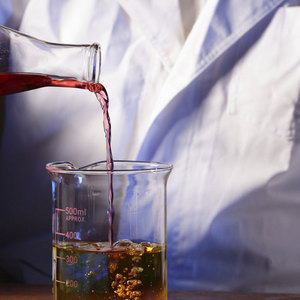May 16, 2008 Research Highlight Chemistry
Copper helps carbon compounds get connected
Medicinal and materials chemists likely to benefit from the development of a reaction to modify benzene-based compounds
 Figure 1: Crude oil can be turned into medicines and useful materials with the help of cunning chemistry that replaces hydrogen atoms.
Figure 1: Crude oil can be turned into medicines and useful materials with the help of cunning chemistry that replaces hydrogen atoms.
A new chemical reaction developed by RIKEN scientists could speed the process of stitching together the molecules that make our medicines and pesticides. The technique allows benzene-based compounds to be precisely modified, allowing chemists to fine-tune their properties.
The scientists’ reaction breaks a chemical bond between a carbon and a hydrogen atom, and then substitutes the hydrogen with a different atom or molecular fragment.
It may sound simple, but this is one of the most important—and tricky—types of reaction in chemistry. Many of the world’s medicines and plastics are derived from oil, which is largely made up of simple chains of carbon atoms bristling with hydrogen atoms. These molecules participate in relatively few chemical reactions—yet substituting hydrogen atoms for nitrogen, oxygen or chlorine can completely change their chemical activity (Fig. 1).
These substitutions must be made at precisely the right spot on the molecule to create a compound with the desired properties for a particular application. But all the carbon-hydrogen bonds have very similar chemical activity, so it is often difficult to make the correct substitution, or to avoid making multiple substitutions.
In benzene (C6H6), a molecule with a hexagonal ring of six carbon atoms at its heart, each carbon atom is bonded to a hydrogen atom. Replacing any of these identical hydrogen atoms creates the same product. But a second substitution must be made in the correct position relative to the first.
Shinya Usui and Masanobu Uchiyama of RIKEN’s Advanced Science Institute (formerly the Discovery Research Institute) in Wako, along with colleagues at the Universities of Tokyo and Cambridge, have developed a reactive chemical that can make sure that second substitution hits its mark1.
Their organocuprate compound unites an atom of copper with organic (carbon-based) molecules, including a bulky nitrogen-containing group called tetra-methyl piperidine.
The scientists found that the organocuprate compound always replaced the hydrogen atom closest to the substituent already attached to the benzene ring, forming a new carbon-copper bond. The copper-based group could then be easily swapped for a variety of other atoms.
The reaction worked on a wide range of different benzene-based molecules, and almost always converted more than 90% of them into the product the scientists wanted. The method could even connect two benzene-based molecules together, providing a useful way to build up large molecules very quickly.
Uchiyama says that this flexible method for constructing such compounds will be of interest to medicinal and materials chemists.
References
- 1. Usui, S., Hashimoto, Y., Morey, J. V., Wheatley, A. E. H. & Uchiyama, M. Direct ortho cupration: a new route to regioselectively functionalized aromatics. Journal of the American Chemical Society 129, 15102–15103 (2007). doi: 10.1021/ja074669i
